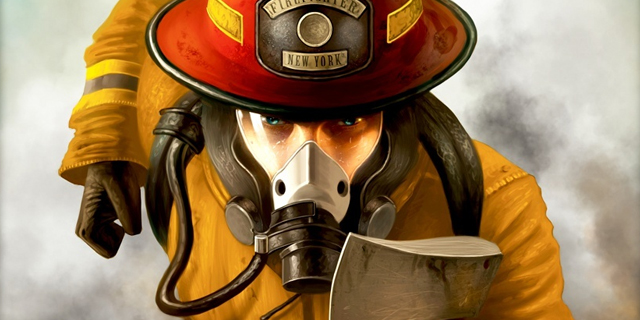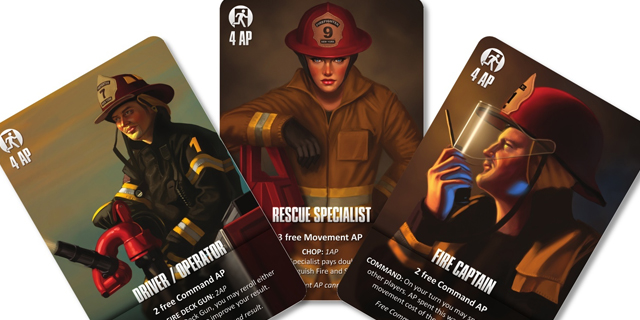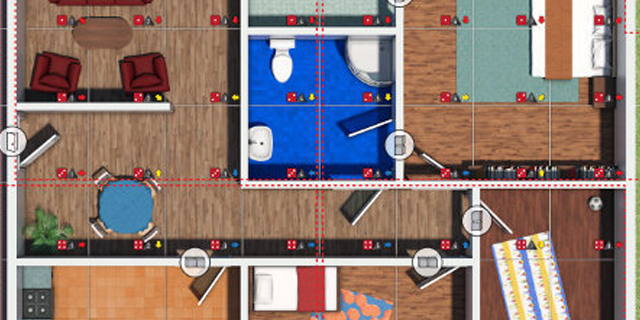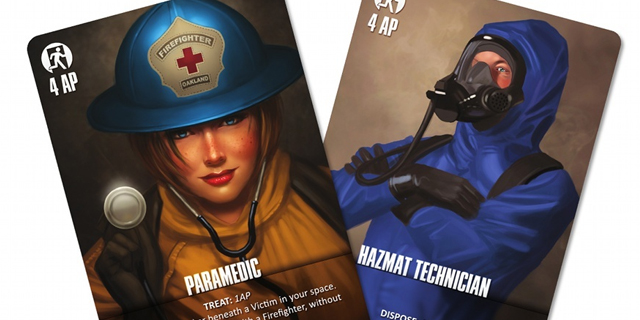
Last time I discussed Pandemic, and while I was on that train of thought, I figured I might as well discuss another cooperative game featuring emergency professionals in Kevin Lanzing’s 2011 offering Flash Point: Fire Rescue (published by Indie Boards & Cards). As might be surmised from the title, Flash Point is a game about a team of firefighters battling a burning building while trying to save the victims trapped inside. Why there are so many victims (as many as ten) in that building is never explained, but fortunately that’s not really an obstacle to enjoying the game.
Flash Point shares many similarities with Pandemic in that each player has a set number of action points (AP) and a special ability that they must use in order to contain a spreading threat while achieving their true objective. These AP can be spent on movement (including opening or closing doors and chopping walls), dealing with the threat (one AP reduces fire to smoke, and one AP eliminates smoke), or working toward the goal. Unlike Pandemic, unspent actions can be saved and carried over to your next turn, up to a limit of four, which can come in handy for a variety of reasons.
Each player’s special ability typically comes in either free AP that can only be spent on specific activities, a reduction in cost to perform certain actions (usually with a corresponding penalty on others) or additional actions that are unavailable to the other players. The goal is to rescue seven victims before the house collapses due to damage, although the game is also lost if four victims are claimed by the blaze before they can be saved.

After each player’s turn, they must roll the dice to determine where the fire spreads. An empty space results in smoke, although any smoke next to a fire will become fire anyway. A space with smoke results in fire. A space with fire results in an explosion, which is generally bad news. This can cause extra damage to the building, as well as making more fire in adjacent spaces — if necessary, flashing over existing fire until it reaches a new space. Obviously any Point of Interest (POI) occupying the same space as fire is destroyed, and any firefighter on a fire space is knocked down and moved directly to the ambulance. Not wanting to end your turn adjacent to a fire is the main reason for carrying over AP to your next turn!
Then, if there are fewer than three POIs on the board (whether via destruction and/or rescue), roll to place new ones until that number has been reached. POIs are often victims, but can also be false alarms; there’s no way to know until you check them out, so you basically have to investigate them all. Once you find a victim, you have to escort them to the waiting ambulance, which will cost you twice as many AP per move as you have to make sure they’re okay. Should it be on the wrong side of the building, the ambulance can be radioed into position for another two or four AP, depending on how far away it is. The firefighters also have access to the powerful deck gun on their engine, which costs four AP to use but can eliminate all fire and smoke on up to five spaces if your roll aims it correctly; the engine can also be repositioned for the same costs as the ambulance, but a player must actually be there to do so.

While the fire is the biggest obstacle, costing additional AP to both move through and fully extinguish while also preventing you from moving a victim through that space at all, the real threat is structural damage to the building. Explosions and the firefighters’ own axes (at two AP a chop) can cause damage to the walls. Two damage to a given wall creates a hole that can be treated like an open door (as do closed doors that get blown open by explosions), but the building can only take twenty-four points of damage total before crashing down on your heads, so chop wisely. A well-positioned hole can greatly aid you in getting victims out, but every swing of your axe brings the house that much closer to collapse.
Further complicating the matter are “hot spots” and hazmats. If the fire spread roll hits a hot spot, it will trigger a second roll even if that space has been extinguished, and no matter where that roll ends up a new hot spot will be generated. Hazmats, of course, react poorly to fire and will both trigger a new explosion in their space as well as generating a new hot spot should the two ever meet. Hazmats can be moved like victims and are disposed of if removed from the building, but nothing can be done about hot spots. The number of initial explosions and hazmats present at start-up determine the difficulty of the game.

There is also a “family” version that doesn’t use the vehicles, hazmats, hot spots or special abilities, that is useful for learning the game but not really an alternative to the full version once you’ve experienced it.”Quarterbacking” can be a problem here, as always, but usually the choices are obvious enough that even new players will pick up on the best course of action fairly quickly. The challenge in Flash Point comes more from knowing when to hold back AP for future turns to minimize your risk while maximizing your usefulness.
Flash Point usually plays in about 45 minutes or less, although until you get the hang of the various AP options and rules for fire spreading that might be on the high side for your first few plays. It scales well from two to six players, and there are two building layouts for additional variety. Some players might get turned off by the reliance on dice to spread the fire, but I actually like that here as it represents the unpredictable and chaotic nature of the blaze. While not quite as thrilling — win or lose — as other cooperative games I’ve covered here, Flash Point is still holds its own and is worth playing.
Flash Point: Fire Rescue retails for around $40.



















